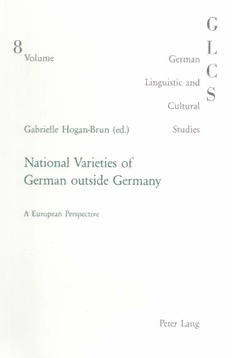
National Varieties of German outside Germany PDF
Preview National Varieties of German outside Germany
G 8 L Volume German c Linguistic and s Cultural Gabrielle Hogan-Brun (e d.) Studies National Varieties of German outside Germany A European Perspective Peter Lang National Varieties of German outside Germany German Linguistic and Cultural Studies Editor: Peter Rolf Lutzeier Volume 8 PETER LANG Oxford· Bern· Berlin· Bruxelles ·Frankfurt am Main· New York· Wien Gabrielle Hogan-Brun (ed.) National Varieties of German outside Germany PE1ERLANG Oxford· Bern· Berlin· Bruxelles ·Frankfurt am Main· New York· Wien Die Deutsche Bibliothek-CIP-Einheitsaufnahme National varieties of German outside Germany / Gabrielle Hogan-Brun (ed.).-Oxford; Bern; Berlin; Bruxelles; Frankfurt am Main ; New York ; Wien : Lang, 2000 (German linguistic and cultural studies; Vol. 8) ISBN 3-906765-58-X British Library and Library of Congress Cataloguing-in-Publication Data: A catalogue record for this book is available from The British Ubrary, Great Britain, and from The Ubrary of Congress, USA ISSN 1422-1454 ISBN 3-906765-58-X US-ISBN 0-8204-5098-7 © Peter Lang AG, European Academic Publishers, Bern 2000 Jupiterstr. 15, Postfach, 3000 Bern 15, Switzerland; [email protected] All rights reserved. All parts of this publication are protected by copyright. Any utilisation outside the strict limits of the copyright law, without the permission of the publisher, is forbidden and liable to prosecution. This applies in particular to reproductions, translations, microfilming, and storage and processing in electronic retrieval systems. Printed in Germany For John, Patrick, Sarah and Christopher This page intentionally left blank Contents Preface 9 oooooooooooooooooooooooooooooooooooooooooooooooooooooooooooooooooooooooooooooooooooooooooooooooo Acknowledgements II 0 0 0 0 0 0 0 0 0 0 0 0 0 0 0 0 0 0 0 0 0 0 0 0 0 0 0 0 0 0 0 0 0 0 0 0 0 00 0 0 0 0 0 0 0 0 0 0 0 0 0 00 0 0 0 0 0 0 0 0 0 0 0 00 0 0 0 0 0 0 00 The Landscapes of German across Europe: An Ecolinguistic Perspective 13 000000 0000 00000000000000000000000000000 00 000000000000000 Gabrielle Hogan-Brun 'Deutsch' as a Linguistic, Ethnic and National Label: Cultural and Political Consequences of a Multiple Ambiguity 33 ooooooooooooooooooooooooooooooooooOooooooooooooooooooooooooooooooooooo Stephen Barbour German as a Minority Language: The Legislative and Policy Framework in Europe 49 000000 oOO 00 000000 0000 oooooooooooooooooooo 00 00000000000000 Stefan Wolff Outsiders' Attitudes towards the Swiss German Dialects and Swiss Standard German 67 ooooooooooooooooooooooo ooooooooo 00000000000 Felicity Rash The German Language in Austria I 03 0 0 0 0 0 0 0 0 0 0 0 0 0 0 0 0 0 0 0 0 0 0 0 0 0 0 0 0 0 00 00 00 0 0 0 0 0 0 0 0 0 0 0 0 0 0 0 0 Victoria Martin German in Old and New Belgium 121 000000000 ooooooooooooooo 000000000000 00 OoooooOOoOOO Peter Nelde and Jeroen Darquennes The Use of German in the Grand Duchy of Luxembourg I39 ooooooooooooooooooooOooOoooooooooooooooooooooooooooooooooooooooooooooooooooooooo Gerald Newton 8 Contents From Tragedy to Triumph: The German Language in South Tyrol 1922-2000 .......................................................... 161 Antony Alcock German as First Language and Minority Second Language in Denmark ................................................................. 195 Karen Margrethe Pedersen Alsatian: A Living Variety? A Sociolinguistic Study of Southern Alsace ........................ 221 Judith Broadbridge The Multilingual Marketplace: German as a Hungarian Language .............................................. 243 Patrick Stevenson Notes on Contributors ..................................................................... 259 Glossary .......................................................................................... 263 Index ............................................................................................... 271 Preface German is widely spoken in many countries outside Germany. These disparate language communities are likely to undergo changes when confronted with the tide of European unification. This collection aims to take stock of the current situation by exploring national varieties of German outside Germany with a focus on status, function and prevailing attitudes. It will provide a composite picture of the nature of 'Germanness' and its ethno-linguistic aspects in the light of the great changes which are underway. The forces released by the ever greater degree of European integration and globalisation affect languages and cultures in two different ways - at one end of the spectrum we see features of a global culture dominated by English as the lingua franca; at the oppo site end of the spectrum the expression of cultural identity and the insistence on cultural distinctiveness challenge this trend of global harmonisation in the area of culture and language. In the face of these two competing, but not necessarily mutually exclusive tendencies, the recognition and safeguarding of cultural and linguistic diversity have become crucial issues of social significance with psychological, cul tural, political, legal and economic implications. Highlighting the different historical/political and cultural tradi tions of German, recognised scholars provide chapters with detailed accounts on the linguistic settings in those countries (I) in which German has the status of a national language and (2) where it has official or regional official status. Consideration is also given to some German-speaking minorities in eastern Europe. For a more detailed account of the latter, the reader is referred to Stefan Wolffs volume on German Minorities in Europe (2000). Wide-ranging explorations of the interrelations between language and society in the German speaking countries are offered in Michael Clyne's book The German Language in a Changing Europe ( 1995) and by Stephen Barbour and Patrick Stevenson in Variation in German ( 1990).
